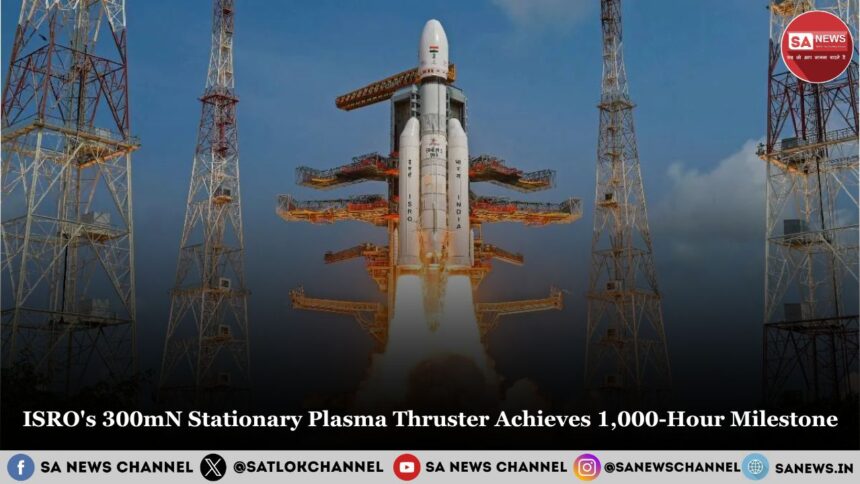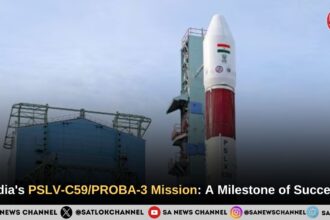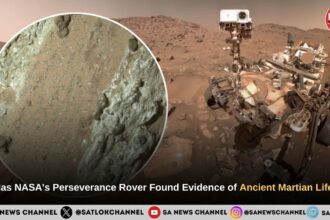The Indian Space Research Organisation (ISRO) has achieved a significant milestone in space technology by successfully completing a 1,000-hour life test of its 300 milli-Newton (mN) Stationary Plasma Thruster (SPT). This marks a pivotal step toward integrating electric propulsion systems into future satellites, offering enhanced efficiency and operational capabilities. The introduction of these thrusters will result in significant mass savings, enabling greater transponder capacity in communication satellites.
Key Highlights
- ISRO successfully completes a 1,000-hour life test of the 300mN Stationary Plasma Thruster (SPT).
- This thruster is designed to enhance electric propulsion for future satellites.
- The test was conducted in a vacuum chamber to simulate space conditions.
- The new propulsion system is six times more efficient than conventional chemical propulsion.
- The thruster will be integrated into ISRO’s upcoming Technology Demonstration Satellite (TDS-01).
- This achievement aligns ISRO with global advancements in electric propulsion technology.
Advancements in Electric Propulsion
Traditionally, satellites have relied on chemical propulsion systems for orbit-raising maneuvers and station-keeping operations. While effective, these systems have limitations due to their lower specific impulse, leading to higher propellant consumption and increased satellite mass.
In contrast, electric propulsion systems, such as the Stationary Plasma Thruster, offer a significantly higher specific impulse—at least six times greater than conventional chemical propulsion systems. This increased efficiency results in considerable mass savings, allowing for the inclusion of additional transponder capacity in communication satellites.
Details of the 1,000-Hour Life Test
The 300mN SPT underwent a rigorous 1,000-hour life test at a full power level of 5.4 kilowatts in a vacuum chamber that simulated space conditions. Throughout the test, the erosion of electrode liners was closely monitored, providing crucial data for predicting the thruster’s longevity and performance in long-duration space missions. ISRO has stated that this information will play an important role in satellite orbit management and operational planning.
Implications for Future Satellite Missions
The successful completion of this extensive life test indicates that the 300mN Stationary Plasma Thruster is now ready for integration into ISRO’s upcoming Technology Demonstration Satellite (TDS-01).
This mission will validate the thruster’s performance in orbit, particularly in tasks such as orbit raising to geostationary positions and precise station-keeping. The transition to electric propulsion systems is expected to revolutionize satellite design and operation by extending mission lifespans and improving fuel efficiency.
Global Context and Competitiveness
ISRO’s advancements in electric propulsion align with global trends in space technology, where agencies and private companies increasingly adopt electric propulsion for its efficiency and cost-effectiveness. By developing indigenous electric propulsion capabilities, ISRO not only enhances India’s technological self-reliance but also strengthens its competitive position in the international space industry. This achievement underscores India’s commitment to advancing space technology and contributing to global space exploration efforts.
Also Read: SpaceX to Launch ISRO’s GSAT-N2 Communication Satellite
A spokesperson from ISRO remarked, “This test is a major milestone in demonstrating the reliability and robustness of the thrusters before induction into satellites. The Electric Propulsion System is planned to be validated in the upcoming Technology Demonstration Satellite (TDS-01) and will be used for orbit raising to geostationary orbit.”
Conclusion
The successful 1,000-hour life test of the 300mN Stationary Plasma Thruster represents a monumental achievement for ISRO and India’s space program. This advancement in electric propulsion technology promises to enhance the efficiency, capacity, and longevity of future satellite missions. As ISRO prepares to integrate this technology into upcoming satellites, the organization continues to demonstrate its commitment to innovation and excellence in space exploration.
Spiritual Perspective by Saint Rampal Ji Maharaj
Just as ISRO’s electric propulsion system enables satellites to function efficiently with minimal fuel, spiritual guidance from a true guru like Saint Rampal Ji Maharaj allows individuals to navigate their lives with wisdom and purpose.
In the same way that traditional chemical propulsion consumes excessive fuel, worldly attachments and ignorance drain human life without achieving true spiritual progress. However, adopting the true knowledge of spirituality, as explained by Saint Rampal Ji, ensures that one’s journey is smooth and purposeful, ultimately leading to liberation (Moksha).
Saint Rampal Ji Maharaj teaches that just as a satellite needs the right propulsion system to reach its destined orbit, a soul requires true spiritual guidance to reach its ultimate abode, Satlok. The scriptures indicate that only through devotion to the Supreme God, as per the methods prescribed in holy texts, can one escape the cycle of birth and death and attain eternal peace.
Those seeking true enlightenment should explore the teachings of Saint Rampal Ji Maharaj, which provide a scientific and logical approach to spirituality. For more details, visit the official YouTube channel of Saint Rampal Ji Maharaj.









